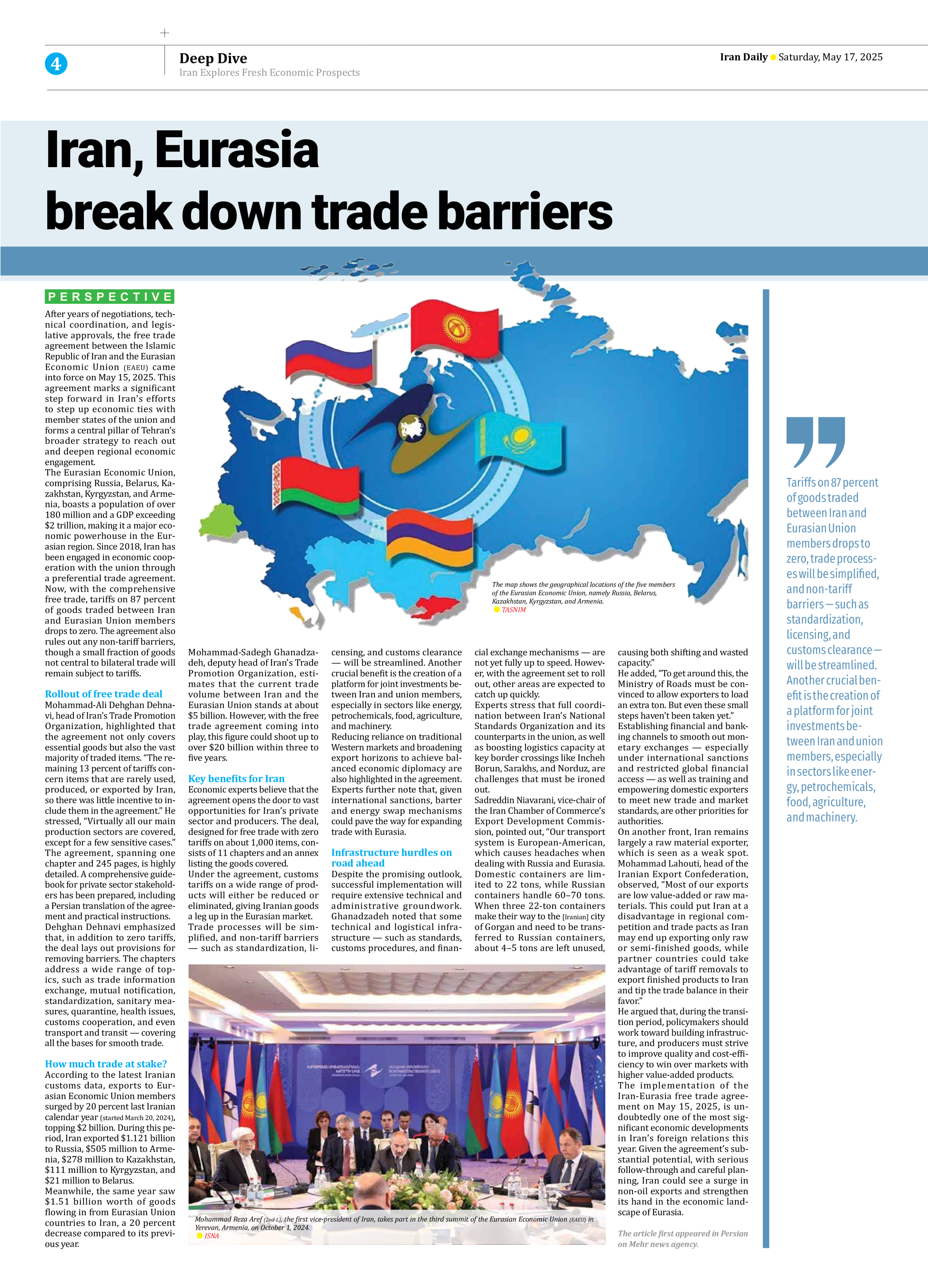
Iran, Eurasia break down trade barriers
After years of negotiations, technical coordination, and legislative approvals, the free trade agreement between the Islamic Republic of Iran and the Eurasian Economic Union (EAEU) came into force on May 15, 2025. This agreement marks a significant step forward in Iran’s efforts to step up economic ties with member states of the union and forms a central pillar of Tehran’s broader strategy to reach out and deepen regional economic engagement.
The Eurasian Economic Union, comprising Russia, Belarus, Kazakhstan, Kyrgyzstan, and Armenia, boasts a population of over 180 million and a GDP exceeding $2 trillion, making it a major economic powerhouse in the Eurasian region. Since 2018, Iran has been engaged in economic cooperation with the union through a preferential trade agreement. Now, with the comprehensive free trade, tariffs on 87 percent of goods traded between Iran and Eurasian Union members drops to zero. The agreement also rules out any non-tariff barriers, though a small fraction of goods not central to bilateral trade will remain subject to tariffs.
Rollout of free trade deal
Mohammad-Ali Dehghan Dehnavi, head of Iran’s Trade Promotion Organization, highlighted that the agreement not only covers essential goods but also the vast majority of traded items. “The remaining 13 percent of tariffs concern items that are rarely used, produced, or exported by Iran, so there was little incentive to include them in the agreement.” He stressed, “Virtually all our main production sectors are covered, except for a few sensitive cases.” The agreement, spanning one chapter and 245 pages, is highly detailed. A comprehensive guidebook for private sector stakeholders has been prepared, including a Persian translation of the agreement and practical instructions.
Dehghan Dehnavi emphasized that, in addition to zero tariffs, the deal lays out provisions for removing barriers. The chapters address a wide range of topics, such as trade information exchange, mutual notification, standardization, sanitary measures, quarantine, health issues, customs cooperation, and even transport and transit — covering all the bases for smooth trade.
How much trade at stake?
According to the latest Iranian customs data, exports to Eurasian Economic Union members surged by 20 percent last Iranian calendar year (started March 20, 2024), topping $2 billion. During this period, Iran exported $1.121 billion to Russia, $505 million to Armenia, $278 million to Kazakhstan, $111 million to Kyrgyzstan, and $21 million to Belarus.
Meanwhile, the same year saw $1.51 billion worth of goods flowing in from Eurasian Union countries to Iran, a 20 percent decrease compared to its previous year.
Mohammad-Sadegh Ghanadzadeh, deputy head of Iran’s Trade Promotion Organization, estimates that the current trade volume between Iran and the Eurasian Union stands at about $5 billion. However, with the free trade agreement coming into play, this figure could shoot up to over $20 billion within three to five years.
Key benefits for Iran
Economic experts believe that the agreement opens the door to vast opportunities for Iran’s private sector and producers. The deal, designed for free trade with zero tariffs on about 1,000 items, consists of 11 chapters and an annex listing the goods covered.
Under the agreement, customs tariffs on a wide range of products will either be reduced or eliminated, giving Iranian goods a leg up in the Eurasian market.
Trade processes will be simplified, and non-tariff barriers — such as standardization, licensing, and customs clearance — will be streamlined. Another crucial benefit is the creation of a platform for joint investments between Iran and union members, especially in sectors like energy, petrochemicals, food, agriculture, and machinery.
Reducing reliance on traditional Western markets and broadening export horizons to achieve balanced economic diplomacy are also highlighted in the agreement. Experts further note that, given international sanctions, barter and energy swap mechanisms could pave the way for expanding trade with Eurasia.
Infrastructure hurdles on road ahead
Despite the promising outlook, successful implementation will require extensive technical and administrative groundwork. Ghanadzadeh noted that some technical and logistical infrastructure — such as standards, customs procedures, and financial exchange mechanisms — are not yet fully up to speed. However, with the agreement set to roll out, other areas are expected to catch up quickly.
Experts stress that full coordination between Iran’s National Standards Organization and its counterparts in the union, as well as boosting logistics capacity at key border crossings like Incheh Borun, Sarakhs, and Norduz, are challenges that must be ironed out.
Sadreddin Niavarani, vice-chair of the Iran Chamber of Commerce’s Export Development Commission, pointed out, “Our transport system is European-American, which causes headaches when dealing with Russia and Eurasia. Domestic containers are limited to 22 tons, while Russian containers handle 60–70 tons. When three 22-ton containers make their way to the [Iranian] city of Gorgan and need to be transferred to Russian containers, about 4–5 tons are left unused, causing both shifting and wasted capacity.”
He added, “To get around this, the Ministry of Roads must be convinced to allow exporters to load an extra ton. But even these small steps haven’t been taken yet.”
Establishing financial and banking channels to smooth out monetary exchanges — especially under international sanctions and restricted global financial access — as well as training and empowering domestic exporters to meet new trade and market standards, are other priorities for authorities.
On another front, Iran remains largely a raw material exporter, which is seen as a weak spot. Mohammad Lahouti, head of the Iranian Export Confederation, observed, “Most of our exports are low value-added or raw materials. This could put Iran at a disadvantage in regional competition and trade pacts as Iran may end up exporting only raw or semi-finished goods, while partner countries could take advantage of tariff removals to export finished products to Iran and tip the trade balance in their favor.”
He argued that, during the transition period, policymakers should work toward building infrastructure, and producers must strive to improve quality and cost-efficiency to win over markets with higher value-added products.
The implementation of the Iran-Eurasia free trade agreement on May 15, 2025, is undoubtedly one of the most significant economic developments in Iran’s foreign relations this year. Given the agreement’s substantial potential, with serious follow-through and careful planning, Iran could see a surge in non-oil exports and strengthen its hand in the economic landscape of Eurasia.
The article first appeared in Persian on Mehr news agency.







